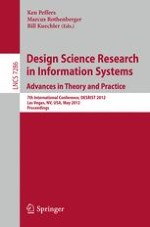2012 | Buch
Design Science Research in Information Systems. Advances in Theory and Practice
7th International Conference, DESRIST 2012, Las Vegas, NV, USA, May 14-15, 2012. Proceedings
herausgegeben von: Ken Peffers, Marcus Rothenberger, Bill Kuechler
Verlag: Springer Berlin Heidelberg
Buchreihe : Lecture Notes in Computer Science
